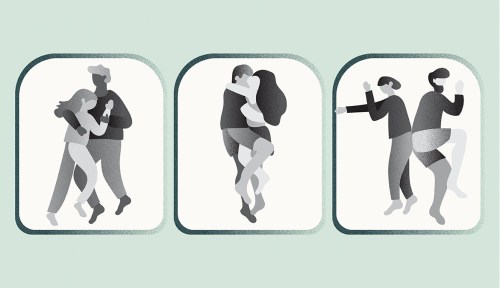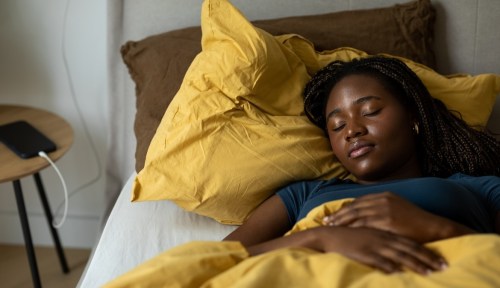Our editors independently select these products. Making a purchase through our links may earn Well+Good a commission
It’s one thing to analyze your own sleeping position, but when you throw a bedmate into the equation, you can glean even more intel from your combined body language. Cuddling up like a pretzel or claiming your side of the bed, for instance, are both common couple sleeping positions that could hint at certain relationship dynamics—so long as you consider a few baseline factors, according to body-language expert Maryann Karinch, co-author of The Body Language Handbook and 365 Ways to Get a Good Night’s Sleep. After all, the most cuddly positions typically aren’t sustainable all night long, and sometimes, staying cool and comfortable beneath the sheets can override a desire to get close to a partner, no matter your feelings for them.
Experts in This Article
body-language expert and co-author of 33 books including The Body Language Handbook
sleep expert and director of the Sleep and Health Research Program at the University of Arizona
body language expert
sleep expert and senior behavioral and social scientist at RAND Corporation
Take spooning with a partner, for example. While this is certainly one of the common couple sleeping positions that might signal romantic connection, it’s also bound to get hot (temperature-wise, that is) after some time. Eventually, the two of you might shift apart, more so for comfort than for any lack of intimacy, says Karinch. And to be clear, that’s totally okay. Plenty of co-sleeping couples prefer to spend the night without making much (if any) physical contact, she adds.
“There’s a wealth of information about you and your mate to be interpreted from a typical sleeping position, since you’re not really thinking about it.” —Patty Wood, body-language expert
Putting aside sheer comfort, however, the physical positioning of a couple in bed can still be revealing in regard to their level of intimacy, says body-language expert Patti Wood, author of Snap: Making the Most of First Impressions, Body Language, and Charisma. That’s because couple sleeping positions tend to happen almost entirely subconsciously at a time when you’re most vulnerable. “There’s a wealth of information about you and your mate to be interpreted from a typical sleeping position, since you’re not really thinking about it,” says Wood. “You’re just doing it.”
Can sleep positions predict relationship success?
According to Wood and Kanrich, a couple’s sleeping position can certainly shed light on elements of their relationship, such as their individual roles and established levels of trust and security. In the early stages of a relationship, in particular, physical closeness in bed can signal greater intimacy and connection, with the person reaching their legs or arms out to connect with their partner or nuzzling their head on or near their chest often demonstrating a feeling of closeness in the relationship.
Though there isn’t research to show that any sleep position can predict relationship success, there is some evidence that a couple’s sleeping position can hint at the relationship’s current status: One 2014 survey of 1,000 people in relationships revealed that 94 percent of those who reported typically spending the night in physical contact with their partner also reported feeling happy in their relationship, compared to only 68 percent of those who didn’t.
What’s more, the level of happiness seemed to decline with greater distance: Roughly 86 percent of those in the survey who slept less than an inch apart from their partner reported being happy with their relationship, but only 66 percent of those who slept more than 30 inches apart reported the same feeling.
That being said, a couple’s sleep position is hardly an end-all-be-all indicator of potential relationship success (or lack thereof). Sure, choosing total opposite ends of the bed could indicate tension between partners, but there are other non-relationship factors that might affect a couple’s sleeping position, too. For example, one partner might simply be opting for a sleep position that alleviates their headaches or choosing from the best sleeping positions to manage other kinds of aches and pains. Or maybe they’re just turning away from their partner at night because their partner is using a bright laptop or phone in bed, says Karinch.
It’s also possible that two partners just have different sleep languages, or sleep habits based on the hurdles they face getting a good night’s rest; one person may struggle with racing thoughts at night and seek comfort in their partner, while the other may feel like they need to follow a specific routine to fall asleep, perhaps involving listening to an audiobook or meditation.
In any case, it’s important not to get too caught up in what your couple’s sleeping position says about your relationship, especially if you know that it’s largely dictated by your or your partner’s individual sleep needs. That said, if you’re eager to know more about what your default co-sleeping position may reveal about your relationship, particularly if you’re in the early stages of dating, read on to find the meanings of 16 common couple sleeping positions, according to sleep and body-language experts.
What do common couple sleeping positions mean?
1. The spoon
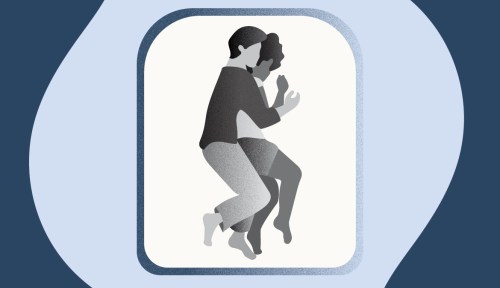
Of all the couple sleeping positions, spooning is one of the most common and recognizable. For spooning newbies, though, this position has one partner enveloping the other in a hug from behind while both lie on one side.
When you and your bedmate start spooning, Karinch says it signifies a certain level of comfort—on both an emotional and physical level. “It’s a sexually vulnerable position,” Karinch says of the butt-to-genitals positioning, which can also be cozy and comforting.
Generally, it’s more common in new couples who are just starting to get vulnerable with each other, says Wood. “You have what I call windows on the front of the body, at your toes, your pelvis, your stomach, your heart, your throat,” she says. “And in a spooning position, the big spoon has all of their windows open to receive the little spoon. It’s saying, ‘I’m confident in myself, and I’m also comfortable with you.’”
In more established couples, that feeling tends to go without saying (er, touching). “It sounds ironic, but a growing level of intimacy can also be accompanied by distancing in the bed,” says Karinch. “At that point, there’s really no need to touch all the time in order to feel secure in the relationship.”
2. The chasing spoon

Another name for this position might as well be the forced spoon. Here, one person retreats to one side of the bed while the other person follows them over there, attempting to spoon them. As you might guess, this type of spooning can signify that both parties aren’t totally on the same page. “For an extended period of time, this can be uncomfortable because it’s hot (as is true with any kind of spooning), but it could also be uncomfortable psychologically because you’re not fully in charge. Instead, you’re being taken over,” Karinch says of the person being “chased.”
Overall, this position could signal that the chaser is a bit overprotective, while the person being chased is seeking some personal space. “If your partner is pulling away from you a bit during the night, don’t necessarily interpret that as, ‘Oh, they don’t want to be intimate with me,’” says Karinch, “but rather that they just need some air.”
3. The butt-kissers
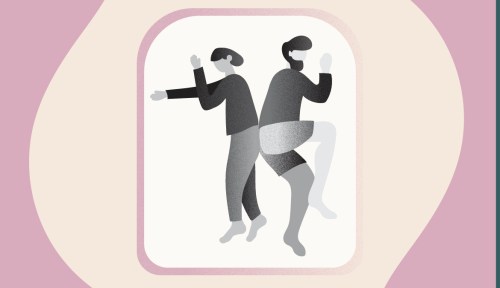
Here, the two partners are sleeping back-to-back with their butts or low backs touching. This position suggests a confident couple, says Wood: “While these two people appreciate their own space and feel comfortable acting independently, they also feel connected to each other, perhaps in a sexual way.” As with spooning, butt-kissing is common for new couples who are building a foundation of intimacy and trust with each other.
4. The liberty lovers
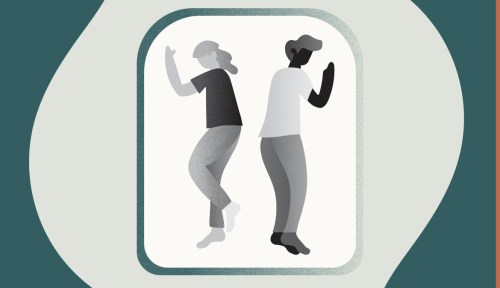
As you might guess by now, sleeping back-to-back without contact—as with this position—isn’t necessarily a bad thing. In some cases, it might just be the natural result of relaxing and drifting off to slumber after untangling from a cuddle knot. “You could feel very secure back-to-back,” says Karinch. Perhaps there’s no inherent need to communicate that physically, or maybe, the novelty of bed-sharing has simply worn off a bit, says Wood, who adds that hot sleepers or folks managing particular health needs, injuries, or menopause might simply default to this position for maximum comfort.
That said, if there’s a sudden shift to this position that can’t be explained by any of the above, this may be a red flag. “It’s possible that there’s a disconnect, or one partner doesn’t feel like the other is fully meeting their needs,” says Wood. “In that case, even if you don’t prefer to touch while you’re sleeping, aim to schedule 15 minutes in the morning or at night with your partner to snuggle, so that you can connect physically, without interfering with either of your sleep.”
5. The gazers

If you were awake, you’d essentially be gazing into each other’s eyes in this position, which has both partners sleeping on their side, directly facing each other. And according to Wood, this position tends to happen in couples that quite literally see eye-to-eye in all things. “Sleeping face to face reflects a desire to keep this incredibly strong cerebral connection throughout the night,” she says.
Though, if one partner suddenly starts to sleep facing the other, it could be a sign that they’ve been feeling distant as of late. “They’re likely hungry for more connection and intimacy,” says Wood.
6. The starfish and the snail
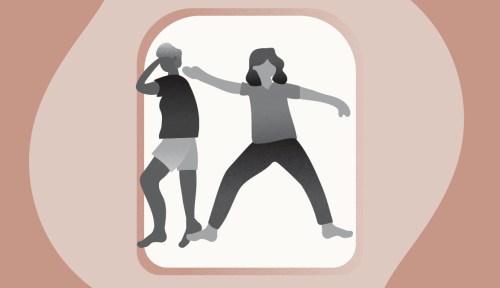
Or, if you’re a real SpongeBob SquarePants fan, “The Patrick and Gary.” This position happens when one person is sprawled all over the bed, and the other has to make themselves more diminutive as a result.
“This can be a sign of selfishness in the partner who’s hogging the bed,” says Karinch. But, that doesn’t necessarily mean the relationship is doomed. If you’re the partner that’s being pushed into snail mode, Karinch suggests simply having an honest talk with the bed hogger about your space needs. That way, if they still continue to encroach on your side, they won’t be surprised to receive a friendly nudge in the rib cage.
7. The nuzzle
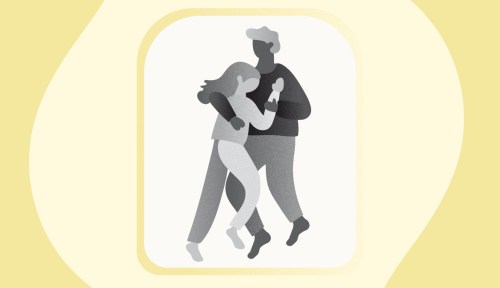
Here, one partner sleeps with their head on the other partner’s chest. “This sleeping position indicates confidence and assurance,” says Wood. The person on their back is typically in the protector role, assuring the other partner of their willingness to support them, while the person resting their head on the first person’s chest feels comfortable depending upon them.
“The head is an incredibly vulnerable part of the body,” adds Wood. “Placing the head on a partner’s chest indicates that you’re willing to share your decision-making and thinking.”
8. The tangle (aka the pretzel)
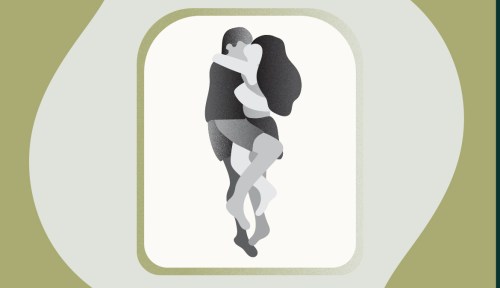
Picture this position as the two partners being all wrapped up—legs, arms, you name it. Generally, it happens in new relationships, where the people involved just can’t seem to get enough of each other’s physical presence. But according to Wood, it can also show up in rekindled relationships or long-term ones where the two people’s lives are deeply intertwined. “Partners who sleep like this tend to function as a unit,” she says.
9. The footsie

Playing footsie in bed can have a similar meaning as playing footsie under the table: “It’s very playful,” says Karinch. “It still allows each partner to take on whatever sleeping position is most comfortable to them, while the light touch of the feet reinforces a sense of attachment.”
But according to Wood, if it happens out of the blue, footsie in bed could have deeper implications than that. “The feet are the most honest part of the body, the first part to move in a fight-or-flight type response, and the part under the least amount of conscious control,” she says. “So, if you get into a disagreement with your partner during the day, but then find your feet locked in bed, that’s a subconscious signal that you’re still feeling connected and you’re not going to stray too far from each other.”
10. The stomach sleepers
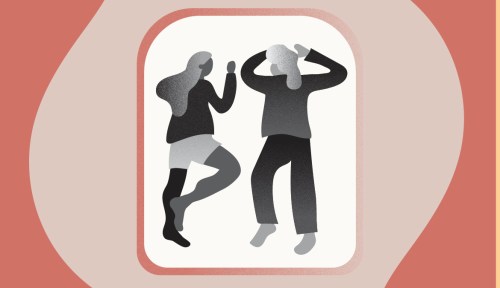
Sleeping facedown is synonymous with closing yourself off. (Remember those “windows” along the front of the body that Wood noted above?) If one or both partners in a relationship are snoozing on their stomach, it could be a sign of anxiety, fear, or hyper-vulnerability, says Wood. “This could be communicating a lack of trust, particularly sexual trust, and it might signal a need for an honest conversation,” she adds. (From a health perspective, stomach sleeping is also not a great sleeping position for aligning your spine and neck, which is why sleep doctors often recommend learning how to not sleep on your stomach.)
11. The uneven back sleepers

You might not initially think anything of one person sleeping with their head closer to the headboard (or wall) than the other, but according to Wood, this can speak to something of a power dynamic in the relationship.
“Typically, the person closer to the headboard is the more dominant or more confident person in the partnership—perhaps they’re the breadwinner or tend to figure in the protector role,” she says. “And the other person might be more submissive or the person being protected.” Of course, she caveats, this doesn’t apply if either person is using a pillow for back or neck reasons that props them higher or lower on the bed.
12. The cliff hanger

If both people are as far apart on the bed as they can be, perhaps with a limb or two dangling off the edge, it’s reasonable to suspect there’s something of a disconnect in the relationship. Assuming that this position isn’t just the result of one or both partners running hot at night (and needing to cool off with an arm or leg out of the covers), it may indicate that one person is seeking independence from the other, or is feeling hurt or disrespected, says Wood. As a result, it’s a sign that a conversation may be needed for both folks to get back on the same wavelength.
13. The tetherball

You might remember playing tetherball during grade-school recess (or know it from the iconic ending scene in Napoleon Dynamite, perhaps). In this position, one person acts as the tetherball pole, extending a hand—the tetherball, so to speak—toward the other partner, thus maintaining a small amount of physical contact while otherwise keeping some separation.
According to Wood, this couple sleeping position reveals a desire to stay connected, especially if the person being touched leans into or embraces the touch, rather than turning away. The person doing the touching may want to comfort or protect their partner or, alternatively, comfort themselves by maintaining some physical contact, no matter how slight.
14. The tree and its shade
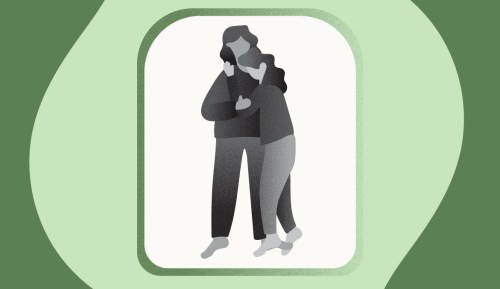
Not to be confused with the “nuzzle” position above, this couple sleeping position (sometimes called the “shingles” position) involves one person sleeping on their back while the other nestles in the crook between the first person’s head and shoulder, rather than on their chest.
Wood says that the one lying flat on their back—the “tree” here—typically holds more power within the relationship, and is likely more confident or assured in it as well. The person nuzzling into the tree’s neck metaphorically rests in their partner’s shade, taking refuge in their partner, says Wood. Depending on the couple, this position could indicate a great deal of trust between the partners, especially for the person lying in the shade of the tree.
15. The bridge
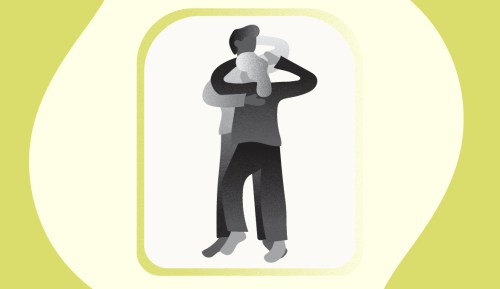
This couple sleeping position involves one partner lying fully on top of the other, who is lying front-side up, such that their chests are touching. It typically happens post-sex, says Wood, before both partners make the conscious decision to go to bed. As such, Wood considers this intimate position a “bridge” between sex and sleep.
“It’s typically done when you don’t want the intimate or pleasurable feeling of the prior sexual experience to end,” says Wood. As such, the “bridge” can reveal a desire within both partners to savor every moment together that they can.
It’s worth noting, however, that with any of these couple sleeping positions, these potential explanations are not definitive—every couple is different, and they might apply better to some than others. What matters most when it comes to your sleeping position with a partner is that it’s allowing you to clock quality sleep while not interfering with your partner’s sleep, either.
16. The paper dolls
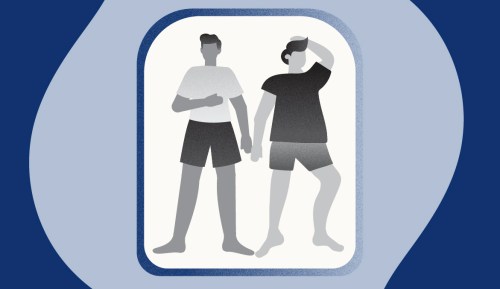
In this position, both partners opt to sleep face-up and side-by-side with minimal physical contact (a gentle hand touch, at most). While the lack of contact could be interpreted as signaling distance in the relationship, “lying on your back [actually] indicates self-confidence and a desire to be in charge and determine your own destiny,” says Wood.
Unless one or both people are lying on their back due to unrelated reasons—like to alleviate back or hip pain—this position could indicate that both partners are so confident in their relationship that they don’t feel the need to seek physical connection overnight for reassurance, says Wood.
How can changing sleep positions improve my relationship?
Just as the quality of your relationship may influence how you sleep with a partner, changing your co-sleeping position could have an effect on your relationship quality. But it’s less about how any particular sleep position can create or signal intimacy than it is about just how well each of you is sleeping. No matter how much you do (or don’t) cuddle with a partner or how you do so, the end goal for your sleeping situation is always maximum comfort for everyone involved. This way, you’re both more likely to reap the benefits of high-quality sleep—and then show up in the relationship as the best version of yourselves.
That means, if your current couple sleeping position is eating into your ability to sleep well, changing it to better suit your sleep needs (whether you need more space, more cuddling, or something else to doze more soundly) can certainly improve your relationship. And the same goes for working with your partner to shift your sleeping position so it aligns with their needs.
Even the process of discussing your sleep with a partner and working together to find a couple sleeping position that jives with both of your sleep needs can strengthen your intimacy and trust in each other. To some hot and bothered sleepers, for instance, asking, “Can I open a window?” is going to be way more romantic than sweating through a night of spooning.
And if it turns out that your sleep preferences are entirely misaligned with your partner’s—maybe you prefer total silence, and they like the hum of a fan; or your sleep chronotype is a night owl, and theirs is an early bird—you can certainly choose to just not sleep together, which is sometimes called a sleep divorce. Despite the name, though, it doesn’t necessarily spell doom for a relationship; in fact, in situations where it promotes better sleep for each partner, it can actually improve a relationship, sleep scientist Wendy Troxel, PhD, previously told Well+Good: “Well-slept partners are simply better partners.”
How to get better sleep with your partner in any of the couple sleeping positions
If you choose to co-sleep with a partner, accommodating for each of your sleep needs can feel like a doozy, particularly if you’ve never shared a bed before. But while some evidence suggests that sleeping in the same bed as a partner can lead to more shallow sleep with more frequent awakenings (you might respond to your bedmate’s noises or movements), there’s also research to show that those who sleep with a partner report higher satisfaction with their sleep1 and may experience improved REM (rapid eye movement) sleep2, says Casper sleep advisor Michael Grandner, PhD, director of the Sleep and Health Research Program at the University of Arizona.
Part of the reason you may actually sleep better with a partner could be tied to the release of the hormone oxytocin, often called the “love hormone” or “cuddling hormone,” which is typically released in response to physical closeness. Over time, you may also simply feel more safe and secure in the presence of your partner, which can down-regulate everyday stress signals and help you doze off more easily, Dr. Troxel previously told Well+Good.
All these benefits of co-sleeping hinge on keeping your sleep disruptions to a minimum, however. If you’re finding that you aren’t able to sleep soundly through the night due to a partner’s noise or light usage (maybe they stay up later or wake up earlier than you prefer), Dr. Grandner recommends earplugs and/or an eye mask. And if it’s their movements that are waking you up, you might consider investing in a split-king mattress (basically, two twin XLs, instead of a single king).
The same concept can apply to your comforter or duvet cover, too: If you tend to hog the covers and leave your partner out in the cold, or vice versa, you may want to try the Scandinavian sleep method, which involves using two twin comforters instead of one queen or king comforter. (This way, you can each cover and uncover yourselves exactly as you wish throughout the night.)
Dealing with different sleep schedules? While Dr. Grandner generally recommends going to bed whenever your body naturally prefers to sleep, he does caveat that spending a few minutes in bed with a partner who goes to bed earlier can also be a good thing, in terms of minimizing stress and enhancing feelings of intimacy. “On the other end of the night, if you’re getting up early, be sure to protect your partner’s sleep as much as you can by keeping the room as dark and quiet as possible,” he says.
Spiegelhalder, Kai et al. “Your Place or Mine? Does the Sleep Location Matter in Young Couples?.” Behavioral sleep medicine vol. 15,2 (2017): 87-96. doi:10.1080/15402002.2015.1083024
↩︎- Drews, Henning Johannes et al. “Bed-Sharing in Couples Is Associated With Increased and Stabilized REM Sleep and Sleep-Stage Synchronization.” Frontiers in psychiatry vol. 11 583. 25 Jun. 2020, doi:10.3389/fpsyt.2020.00583↩︎
Sign Up for Our Daily Newsletter
Get all the latest in wellness, trends, food, fitness, beauty, and more delivered right to your inbox.
Got it, you've been added to our email list.
